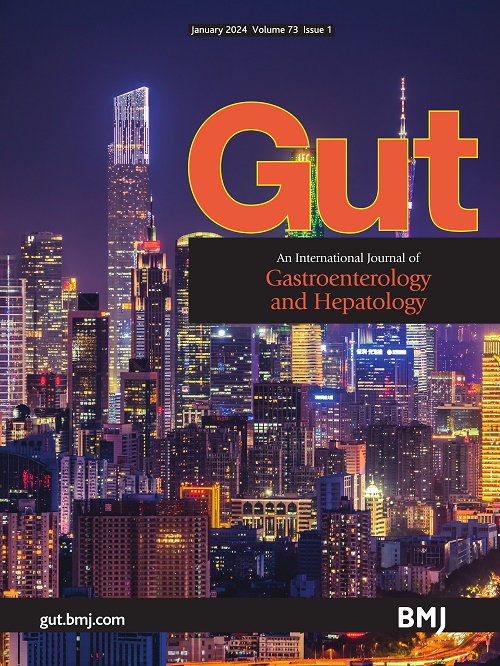Mucosal transcriptomic landscape along the small and large intestines in individuals with and without type 2 diabetes
IF 25.8
1区 医学
Q1 GASTROENTEROLOGY & HEPATOLOGY
引用次数: 0
Abstract
Background A detailed mapping of functional differences among intestinal regions in healthy individuals remains incomplete. Identifying regional alterations in individuals with type 2 diabetes (T2D) could enhance our understanding of disease-related intestinal changes. Objective To characterise the transcriptomic landscape along the entire intestinal tract in healthy individuals and those with T2D, and to create a publicly accessible database for future research. Design In this observational study, mucosal biopsies were obtained from 16 sites along the intestinal tract through anterograde and retrograde double-balloon endoscopy in 12 individuals with T2D and 12 normoglycaemic matched healthy individuals. Full transcriptomic analysis was performed. Genes with significantly different expressions between intestinal regions were analysed in terms of their biological mechanisms in healthy individuals, while regional expression profiles were compared between individuals with and without T2D. Results In healthy individuals, distinct gene clusters in the small and large intestines were associated with processes including immune response, mitochondrial activity and metabolism of organic substances. Individuals with T2D exhibited alterations in immune system activity and barrier permeability in the ileocaecal region and the large intestine. Conclusion Our study offers a detailed mapping of the transcriptomic landscape in the human intestinal tract, demonstrating regionalised gene expression profiles tied to critical biological processes. Notable alterations in immune system activity in the large intestine were observed in individuals with T2D. The publicly available database generated from this study (2型糖尿病患者和非2型糖尿病患者小肠和大肠粘膜转录组学研究
健康个体肠道区域功能差异的详细图谱尚不完整。确定2型糖尿病(T2D)患者的区域改变可以增强我们对疾病相关肠道变化的理解。目的了解健康个体和T2D患者整个肠道的转录组学特征,并为未来的研究建立一个可公开访问的数据库。在这项观察性研究中,通过顺行和逆行双球囊内窥镜对12名T2D患者和12名血糖正常的健康人进行了肠道16个部位的粘膜活检。进行全转录组学分析。分析了健康个体肠道区域间表达差异显著的基因的生物学机制,并比较了有和无T2D个体之间的区域表达谱。结果在健康个体中,小肠和大肠中不同的基因簇与免疫反应、线粒体活性和有机物代谢等过程相关。T2D患者表现出免疫系统活性和回盲区和大肠屏障通透性的改变。我们的研究提供了人类肠道转录组景观的详细图谱,展示了与关键生物过程相关的区域化基因表达谱。在T2D患者中观察到大肠免疫系统活性的显著改变。本研究生成的公开可用数据库()为探索人类肠道粘膜转录组提供了宝贵的资源。试验注册号[NCT03044860][1]数据可在公共开放存取存储库中获得。匿名mRNA数据可在。研究方案作为数据补充包含在本文的在线版本中。[1]: /查找/ external-ref ? link_type = CLINTRIALGOV&access_num = NCT03044860&atom = % 2 fgutjnl % 2恐惧% 2 f2025 % 2 f08 % 2 f12 % 2 fgutjnl - 2024 - 334124. -原子
本文章由计算机程序翻译,如有差异,请以英文原文为准。
求助全文
约1分钟内获得全文
求助全文
来源期刊

Gut
医学-胃肠肝病学
CiteScore
45.70
自引率
2.40%
发文量
284
审稿时长
1.5 months
期刊介绍:
Gut is a renowned international journal specializing in gastroenterology and hepatology, known for its high-quality clinical research covering the alimentary tract, liver, biliary tree, and pancreas. It offers authoritative and current coverage across all aspects of gastroenterology and hepatology, featuring articles on emerging disease mechanisms and innovative diagnostic and therapeutic approaches authored by leading experts.
As the flagship journal of BMJ's gastroenterology portfolio, Gut is accompanied by two companion journals: Frontline Gastroenterology, focusing on education and practice-oriented papers, and BMJ Open Gastroenterology for open access original research.
 求助内容:
求助内容: 应助结果提醒方式:
应助结果提醒方式:


